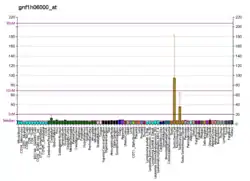DEFB129
Beta-defensin 129 is a protein that in humans is encoded by the DEFB129 gene.[4][5]
| DEFB129 | |||||||||||||||||||||||||
|---|---|---|---|---|---|---|---|---|---|---|---|---|---|---|---|---|---|---|---|---|---|---|---|---|---|
| Identifiers | |||||||||||||||||||||||||
| Aliases | DEFB129, C20orf87, DEFB-29, DEFB29, bA530N10.3, hBD-29, defensin beta 129 | ||||||||||||||||||||||||
| External IDs | MGI: 3644405 HomoloGene: 83411 GeneCards: DEFB129 | ||||||||||||||||||||||||
| |||||||||||||||||||||||||
| |||||||||||||||||||||||||
| Orthologs | |||||||||||||||||||||||||
| Species | Human | Mouse | |||||||||||||||||||||||
| Entrez | |||||||||||||||||||||||||
| Ensembl | |||||||||||||||||||||||||
| UniProt | |||||||||||||||||||||||||
| RefSeq (mRNA) | |||||||||||||||||||||||||
| RefSeq (protein) | |||||||||||||||||||||||||
| Location (UCSC) | Chr 20: 0.23 – 0.23 Mb | n/a | |||||||||||||||||||||||
| PubMed search | [2] | [3] | |||||||||||||||||||||||
| Wikidata | |||||||||||||||||||||||||
| |||||||||||||||||||||||||
Defensins are cysteine-rich cationic polypeptides that are important in the immunologic response to invading microorganisms. The protein encoded by this gene is secreted and is a member of the beta defensin protein family. Beta defensin genes are found in several clusters throughout the genome, with this gene mapping to a cluster at 20p13.[5]
References
- GRCh38: Ensembl release 89: ENSG00000125903 - Ensembl, May 2017
- "Human PubMed Reference:". National Center for Biotechnology Information, U.S. National Library of Medicine.
- "Mouse PubMed Reference:". National Center for Biotechnology Information, U.S. National Library of Medicine.
- Schutte BC, Mitros JP, Bartlett JA, Walters JD, Jia HP, Welsh MJ, Casavant TL, McCray PB Jr (Feb 2002). "Discovery of five conserved β-defensin gene clusters using a computational search strategy". Proc Natl Acad Sci U S A. 99 (4): 2129–33. doi:10.1073/pnas.042692699. PMC 122330. PMID 11854508.
- "Entrez Gene: DEFB129 defensin, beta 129".
Further reading
- Gerhard DS, Wagner L, Feingold EA, et al. (2004). "The Status, Quality, and Expansion of the NIH Full-Length cDNA Project: The Mammalian Gene Collection (MGC)". Genome Res. 14 (10B): 2121–7. doi:10.1101/gr.2596504. PMC 528928. PMID 15489334.
- Clark HF, Gurney AL, Abaya E, et al. (2003). "The Secreted Protein Discovery Initiative (SPDI), a Large-Scale Effort to Identify Novel Human Secreted and Transmembrane Proteins: A Bioinformatics Assessment". Genome Res. 13 (10): 2265–70. doi:10.1101/gr.1293003. PMC 403697. PMID 12975309.
- Rodríguez-Jiménez FJ, Krause A, Schulz S, et al. (2003). "Distribution of new human beta-defensin genes clustered on chromosome 20 in functionally different segments of epididymis". Genomics. 81 (2): 175–83. doi:10.1016/S0888-7543(02)00034-4. PMID 12620395.
- Kao CY, Chen Y, Zhao YH, Wu R (2003). "ORFeome-based search of airway epithelial cell-specific novel human [beta]-defensin genes". Am. J. Respir. Cell Mol. Biol. 29 (1): 71–80. CiteSeerX 10.1.1.108.7808. doi:10.1165/rcmb.2002-0205OC. PMID 12600824.
- Strausberg RL, Feingold EA, Grouse LH, et al. (2003). "Generation and initial analysis of more than 15,000 full-length human and mouse cDNA sequences". Proc. Natl. Acad. Sci. U.S.A. 99 (26): 16899–903. doi:10.1073/pnas.242603899. PMC 139241. PMID 12477932.
- Deloukas P, Matthews LH, Ashurst J, et al. (2002). "The DNA sequence and comparative analysis of human chromosome 20". Nature. 414 (6866): 865–71. doi:10.1038/414865a. PMID 11780052.
This article is issued from Wikipedia. The text is licensed under Creative Commons - Attribution - Sharealike. Additional terms may apply for the media files.


